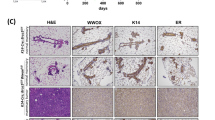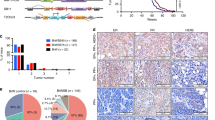Abstract
BRCA2 is a breast cancer susceptibility gene. Germline mutations of BRCA2 account for about 10–30% of familial breast cancer cases. Consistent with its tumor-suppressor activity, BRCA2 plays an important role in DNA repair. To assess the susceptibility of carriers of mutant BRCA2 to tumorigenesis induced by DNA-damaging carcinogens, we generated a Brca2 knockout mouse strain and studied its susceptibility to chemically induced tumorigenesis. Similar to previously reported Brca2 knockout mice, our Brca2−/− embryos die at E8.5–9.5, while the Brca2+/− mice are tumor-free and fertile. Unexpectedly, Brca2+/− mice developed tumors slower than did their wild-type littermates when treated with a potent carcinogen 7,12-dimethylbenz[a]anthracene (DMBA). In vitro experiments showed that Brca2+/− mouse cells and Capan-1 cells, a human pancreatic cancer cell line deficient of BRCA2, were more sensitive to DMBA-induced apoptosis, than were Brca2+/+ mouse cells and a derivative of Capan-1 cells that expressed exogenous wild-type BRCA2, respectively. Our results suggest that enhanced sensitivity of Brca2 mutant cells to DMBA-induced apoptosis at the dose of DMBA we used contributes to the delayed tumorigenesis of Brca2+/− animals. This suggestion may also provide a rational explanation for a previous unexpected finding that cigarette smoking appears to reduce the breast cancer risk of BRCA2 mutation carriers.
This is a preview of subscription content, access via your institution
Access options
Subscribe to this journal
Receive 50 print issues and online access
$259.00 per year
only $5.18 per issue
Buy this article
- Purchase on Springer Link
- Instant access to full article PDF
Prices may be subject to local taxes which are calculated during checkout




Similar content being viewed by others
Abbreviations
- DMBA:
-
7,12-dimethylbenz[a]anthracene
- MPA:
-
medroxyprogesterone acetate
- FIAU:
-
1-[2′-deoxy-2′-fluoro-b-D-arabinofuranosyl]-5-iodouracil
References
Abbott DW, Freeman ML and Holt JT . (1998). J. Natl. Cancer Inst., 90, 978–985.
Aldaz CM, Liao QY, LaBate M and Johnston DA . (1996a). Carcinogenesis, 17, 2069–2072.
Aldaz CM, Liao QY, Paladugu A, Rehm S and Wang H . (1996b). Mol. Carcinogen., 17, 126–133.
Bennett LM, McAllister KA, Blackshear PE, Malphurs J, Goulding G, Collins NK, Ward T, Bunch DO, Eddy EM, Davis BJ and Wiseman RW . (2000). Mol. Carcinogen., 28, 174–183.
Boyd J, Sonoda Y, Federici MG, Bogomolniy F, Rhei E, Maresco DL, Saigo PE, Almadrones LA, Barakat RR, Brown CL, Chi DS, Curtin JP, Poynor EA and Hoskins WJ . (2000). JAMA, 283, 2260–2265.
Brunet JS, Ghadirian P, Rebbeck TR, Lerman C, Garber JE, Tonin PN, Abrahamson J, Foulkes WD, Daly M, Wagner-Costalas J, Godwin A, Olopade OI, Moslehi R, Liede A, Futreal PA, Weber BL, Lenoir GM, Lynch HT and Narod SA . (1998). J. Natl. Cancer Inst., 90, 761–766.
Connor F, Bertwistle D, Mee PJ, Ross GM, Swift S, Grigorieva E, Tybulewicz VL and Ashworth A . (1997). Nat. Genet., 17, 423–430.
Ding Y, Wen Y, Spohn B, Wang L, Xia W, Kwong KY, Shao R, Li Z, Hortobagyi GN, Hung MC and Yan DH . (2002). Clin. Cancer Res., 8, 3290–3297.
Egawa C, Miyoshi Y, Takamura Y, Taguchi T, Tamaki Y and Noguchi S . (2001). Int. J. Cancer, 95, 255–259.
Friedman LS, Thistlethwaite FC, Patel KJ, Yu VP, Lee H, Venkitaraman AR, Abel KJ, Carlton MB, Hunter SM, Colledge WH, Evans MJ and Ponder BA . (1998). Cancer Res., 58, 1338–1343.
Gavrieli Y, Sherman Y and Ben-Sasson SA . (1992). J. Cell Biol., 119, 493–501.
Goggins M, Schutte M, Lu J, Moskaluk CA, Weinstein CL, Petersen GM, Yeo CJ, Jackson CE, Lynch HT, Hruban RH and Kern SE . (1996). Cancer Res., 56, 5360–5364.
Hecht SS . (2002). Environ. Mol. Mutagen., 39, 119–126.
Kaplan EL and Meier P . (1958). J. Am. Stat. Assoc., 53, 457–481.
Knudson Jr AG . (1971). Proc. Natl. Acad. Sci. USA, 68, 820–823.
Levine DA, Federici MG, Reuter VE and Boyd J . (2002). Gynecol. Oncol., 85, 431–434.
Ludwig T, Chapman DL, Papaioannou VE and Efstratiadis A . (1997). Genes Dev., 11, 1226–1241.
Ludwig T, Fisher P, Murty V and Efstratiadis A . (2001). Oncogene, 20, 3937–3948.
Maniatis T, Fritsch EF and Sambrook J . (1982). Molecular Cloning – A Laboratory Manual. Harbor Laboratory: Cold Spring.
McAllister KA, Bennett LM, Houle CD, Ward T, Malphurs J, Collins NK, Cachafeiro C, Haseman J, Goulding EH, Bunch D, Eddy EM, Davis BJ and Wiseman RW . (2002). Cancer Res., 62, 990–994.
McMahon AP and Bradley A . (1990). Cell, 62, 1073–1085.
Morimatsu M, Donoho G and Hasty P . (1998). Cancer Res., 58, 3441–3447.
Orelli BJ and Bishop DK . (2001). Breast Cancer Res., 3, 294–298.
Patel KJ, Vu VP, Lee H, Corcoran A, Thistlethwaite FC, Evans MJ, Colledge WH, Friedman LS, Ponder BA and Venkitaraman AR . (1998). Mol. Cell, 1, 347–357.
Pena JC, Rudin CM and Thompson CB . (1998). Cancer Res., 58, 2111–2116.
Schwab M, Claas A and Savelyeva L . (2002). Cancer Lett., 175, 1–8.
Scully R and Puget N . (2002). Biochimie, 84, 95–102.
Sharan SK and Bradley A . (1997). Genomics, 40, 234–241.
Su LK, Wang SC, Qi Y, Luo W, Hung MC and Lin SH . (1998). Oncogene, 17, 2377–2381.
Suzuki A, de la Pompa JL, Hakem R, Elia A, Yoshida R, Mo R, Nishina H, Chuang T, Wakeham A, Itie A, Koo W, Billia P, Ho A, Fukumoto M, Hui CC and Mak TW . (1997). Genes Dev., 11, 1242–1252.
Venkitaraman AR . (2001a). Curr. Opin. Cell Biol., 13, 338–343.
Venkitaraman AR . (2001b). J. Cell Sci., 114, 3591–3598.
Venkitaraman AR . (2002). Cell, 108, 171–182.
Wang SC, Shao R, Pao AY, Zhang S, Hung MC and Su LK . (2002). Cancer Res., 62, 1311–1314.
Welcsh PL and King MC . (2001). Hum. Mol. Genet., 10, 705–713.
Zheng L, Li S, Boyer TG and Lee WH . (2000). Oncogene, 19, 6159–6175.
Acknowledgements
We thank Dr Shih-Jen Hwang for the assistance in the statistical analysis and Dr Chun-Ming Chen for analysing the development of mouse embryos. This work was supported in part by Faculty Achievement Award (MCH), the MD Anderson Breast Cancer Research Program, and grants RO1CA58880 (MCH), RO1CA 77858 (MCH), and Cancer Center Core Grant CA16672 from the NIH.
Author information
Authors and Affiliations
Corresponding author
Rights and permissions
About this article
Cite this article
Yan, DH., Wen, Y., Su, LK. et al. A delayed chemically induced tumorigenesis in Brca2 mutant mice. Oncogene 23, 1896–1901 (2004). https://doi.org/10.1038/sj.onc.1207314
Received:
Revised:
Accepted:
Published:
Issue Date:
DOI: https://doi.org/10.1038/sj.onc.1207314



